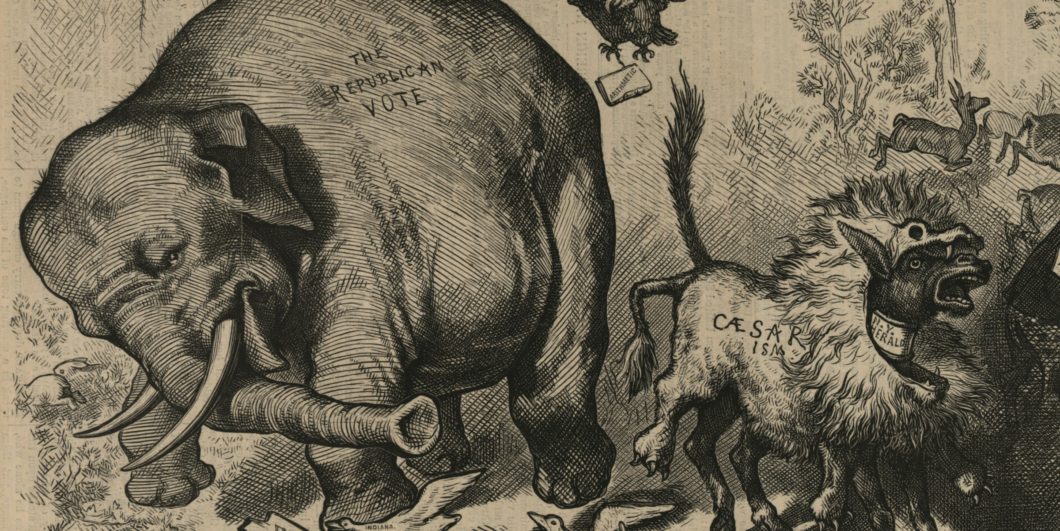Despite all appearances, the Democratic takeover of the House increases the odds of Trump’s reelection in 2020.
Michael Barone and the Life of the Party
Perhaps the best way to explain Michael Barone’s latest book, How America’s Political Parties Change (and How They Don’t), is to recount my first meeting with him. It was 2011, and I was delighted to have been selected to appear on a panel with National Journal’s Josh Kraushaar and Barone. As a newly minted elections analyst with an interest in the minutiae of political and electoral history, I was determined to impress him.
When we got to the Q&A section of the panel, I was given the opportunity to give the first answer. I began unloading my knowledge of political history. I spoke of Roosevelt’s unsuccessful purge of conservative Southern Democrats in 1938, but noted that he had also targeted a conservative Northern Democrat. That challenge was successful, but led to the seat flipping to Republicans; this seemed like an appropriate lesson for the largely Republican audience in the wake of the 2010 elections. I went on to discuss the spate of Southern Republican victories in congressional elections that had begun in the 1950s and finished up quite pleased with myself.
I don’t think he meant what followed as any sort of “mic drop” moment—this is just who Michael Barone is—but when it was his turn to speak, any sense of satisfaction I had about my performance evaporated. He proceeded to talk, in detail, about ward-level politics in Chicago in the 1930s, rattling off, without pause, the ward bosses, the ethnicities they represented, and how their voting patterns had shifted over the course of the decade. He seamlessly tied all this into a story of political change in America. That was when I realized that there will likely never be another person with Barone’s granular command of political history in America. That is what makes his books so special.
Barone grew up in Detroit in the 1950s and 60s and, by his own account, was introduced to elections when trying to explain different voting patterns in the suburbs. He began creating hand-drawn maps of the precinct results, concluding that religion drove much of the difference. While at Yale Law School, he and two classmates built upon this granular knowledge of elections to produce the first Almanac of American Politics. Initially intended as a guide for youth protesting the Vietnam War (Barone’s politics were on the Left at the time, though they have since veered rightward), it is currently on its 26th edition after developing into something of a political bible for the DC media establishment.
This is what makes How America’s Political Parties Change stand out. Over the course of the past two decades, we have seen the rise of a cottage industry of books suggesting that one party or the other was headed toward a dominant position in America. None of these books, however, has been written by someone with Barone’s encyclopedic knowledge of American political history. It’s no great exaggeration to say that this represents the culmination of Barone’s experience examining American elections over the past 60 years.
The book is a quick read. It is composed of several short chapters (the longest is twelve pages long and many of them number around five) but is divided into three parts, which we might think of as “stories.” The first is a story of party development in the early 20th century and sets out what we might consider Barone’s twin theses. The first is that America’s political parties, which are, as he likes to point out, the first and third oldest political parties in the world, have a longstanding thread that connects them. From Andrew Jackson speaking up for backcountry Scots-Irish farmers, to William Jennings Bryan taking a similar case to the farmers on the plains, to FDR melding those concerns with those of working-class Catholic city-dwellers, to Obama’s modern focus on marginalized groups, the thread among Democrats has been that they speak for America’s outgroups.
At the same time, Republicans’ focus has been on various collections of ingroups. We can see this notion validated with just a cursory march through the 19th and 20th centuries. In the 1880s, Republicans were more closely associated with the concerns of mainline protestants than were the Democrats: They championed Blaine Amendments, which restricted the flow of funds to Catholic institutions, and were more closely associated with Prohibition. Later, they were the party of management in its disputes with labor; later still they associated themselves with “traditional values.”
While we might be tempted to bet on a permanent majority for Democrats or Republicans in the coming years, we would be betting on something that exists only in the mythologies of our political history.
While there is much to recommend this view of party history, it does run into problems. One might wonder, for example, how slavery fits into this particular narrative. This seems like a clear example of the Republican Party associating itself with the ultimate outgroup, while Democrats reflected the viewpoint of the patrician South. Perhaps this dilemma can be solved by noting abolitionism’s relationship to northern mainline protestant thinking, but surely more needs to be said on this topic. Also, one is left wondering if these threads are fraying today as suburbanites gravitate toward the Democrats and working-class whites toward Republicans. This probably deserves a “to be determined” label.
Barone’s second thesis is the better-developed of the two. He observes that, at least in America, these parties do not die. Rather, they adapt to changing circumstances by co-opting groups that inevitably become dissatisfied with the other party’s style of governance. Governing a large, diverse, transcontinental empire is hard, and adopting a governing strategy that pleases everyone is practically impossible.
Barone’s story focuses here on the early half of the 20th century. While most people are familiar with the realignment of the 1930s—at one point there were almost as many Democrats in the Senate than there were Republicans in the House—Barone’s story begins a decade earlier, with the 1920 presidential election. In that election, held in the waning years of Woodrow Wilson’s disastrous presidency, Democrats were left in almost as precarious a position as Republicans were after 1936. Democrats were reduced to 37 Senate seats, 22 of which were in the “Solid South,” and 131 House seats, only a dozen or so of which were held outside of the South and border states. Yet by the end of the decade, events were set in motion that would lead proximately to the Democrats amassing supermajorities in both houses of Congress.
Even these supermajorities, Barone notes, were not as durable as often thought: Republicans nearly won the popular vote for the House in 1938, won the popular vote (but not control) in 1942, and won both houses of Congress in 1946. In other words, while we might be tempted to bet on a permanent majority for Democrats or Republicans in the coming years, we would be betting on something that exists only in the mythologies of our political history; reality is much more fluid.
Barone’s second and third stories fall downstream from the first. The second portion of the book applies his insights about party development to two of the most notable shifts of recent years: the shedding of the liberal wing from the Republican Party and the exodus of the conservative wing of the Democratic Party. Apologists for both parties have commented on these developments almost endlessly, with Democrats focusing on the Republican “Southern Strategy” to peel off Southern Democrats, and Republicans claiming the success of the Reagan Administration’s approach to taxation and cultural issues as the cause.
For Barone, this is backwards. Conservative Democrats left the Democratic Party, in his reckoning, because of the Vietnam War and the cultural upheaval of the 60s, while the resurgent progressive wing of the party finally succeeded in destroying the machine Democrats in the nation’s major cities at the same time. This provided the necessary precondition for liberal Republicans to leave their party. They were already largely ideologically sympathetic with the emerging Democratic Party, but found caucusing with segregationists such as Jim Eastland too distasteful. The exodus of racial conservatives from the Democratic Party functioned to remove this obstacle.
In his final two chapters, which are also his lengthiest, Barone departs from strictly chronological stories and focuses on two regional stories: the South and the Midwest. For the South, much of the story will be familiar to readers, as he lays out the creation of a Southern exception to broader American culture. He updates the story from 2016, however, exploring some of the fissures between Republicans and Southerners that we caught a glimpse of in 2018, and that may blow open in 2020. His treatment of the Midwest is more novel, as he explains the development of the nation’s perennial swing region, and illustrates its shift to the Right in the last few election cycles.
This review may seem filled with “spoilers.” After seeing Barone’s theses spelled out, why read this short book? The answer comes from the opening anecdote. A Michael Barone book is not necessarily to be read for the theses it spells out, but rather for the details. Unlike many books in this genre, many of which border on the polemic, a reader who spends a day working through this book will emerge having learned more about American political history than from reading a dozen typical popular-press books. It’s a thorough explanation of modern political history, which any aficionado of politics and elections would be foolish to pass up.


